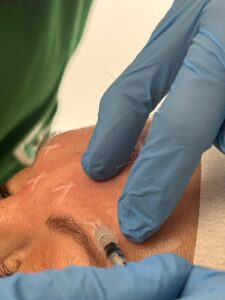Botox
Botox® injections improve appearance by relaxing muscles that cause wrinkles. These injections also treat medical conditions, including migraines, hyperhidrosis, overactive bladder and eye problems. To maintain results, treatments should be repeated every three to six months.
What is Botox®?
Botox® is one of the most widely known brands of botulinum toxin injections. Botulinum toxins are neurotoxins that affect nerves and cause muscle weakening.You might get a botulinum toxin injection for cosmetic or medical reasons. Healthcare providers inject small amounts of Botox into specific muscles to smooth wrinkles, prevent migraine headaches and treat a wide range of other health conditions.
How does Botox work?
Botox blocks nerve signals to muscles. As a result, injected muscles can’t contract (tense up). These effects are always temporary, but can last for several months. The muscle injected depends on the primary area of concern. Several areas can be treated in one session.
What cosmetic conditions can be treated with Botox?
Botox cosmetic injections are used to address signs of aging. This treatment can smooth fine lines and wrinkles in several areas of your face, including your:
- Eyebrows.
- Forehead.
- Nose.
- Eyes (crow’s feet).
- Lips.
- Chin.
- Jawline.
- Neck.
What medical conditions can be treated with Botox in our clinic?
- Dystonia.
- Excessive sweating (hyperhidrosis)
- Chronic migraines.
- TMJ pain.
- Neck pain.
- Jaw pain.
Is Botox safe?
Botox is generally safe when administered by a licensed healthcare provider. Ask your medical team if Botox injections are right for you.
How should I prepare for Botox?
Make sure your healthcare provider has a current list of the medications and supplements you take. Certain medications increase the risk of bruising at the injection site. These include anticoagulants or blood thinners (Warfarin) and NSAIDs. Alcohol also makes you more prone to redness and bruising. Don’t drink for 24 hours before a procedure.
What should I expect during Botox treatment?
Your healthcare provider uses a fine needle to inject small amounts of Botox into the treatment area. Depending on the issue, you may receive several injections in different spots. Here’s what else you need to know about Botox therapy:
- Botox is an outpatient procedure. You’ll be able to go home the same day.
- Discomfort is usually mild. The injections may sting and feel uncomfortable, but the procedure is over quickly. Your healthcare provider might apply a topical numbing agent to your skin before giving injections.
What should I know about Botox aftercare?
Unless your healthcare provider says otherwise, you can return to work and most activities immediately after treatment. To reduce redness, swelling or bruising:
- Don’t rub or put pressure on the treatment area for 12 hours.
- Stay upright (don’t lie down) for three to four hours.
- Avoid physical exertion for 24 hours.
How often should you get Botox?
On average, the effects of Botox last about three to four months. Retreatment is recommended at this time. Eventually, however, your muscles may train themselves to contract less. As a result, treatments can be spaced out over longer periods of time. Your healthcare provider can let you know how often you should get Botox based on your unique needs.
Are there any Botox side effects?
Side effects from botulinum toxin injections vary depending on the area receiving treatment. Most issues are mild and improve in a day or two. Possible Botox side effects include:
- Pain, swelling, redness or bruising at the treatment site.
- Flu-like symptoms.
- Headache.
- Neck pain.
- Upset stomach (indigestion).
- Temporary drooping eyelids (ptosis)
- Eye irritation or redness.
Who should not get Botox injections?
Botox injections are relatively safe. Still, you shouldn’t get this treatment if you’re pregnant, breastfeeding or have:
- Neuromuscular disease.
- Drooping eyelids (ptosis).
- Weak facial muscles.
How long does it take for Botox to work?
After Botox treatment, most people notice the desired effects around the third or fourth day. Full results will be visible within 10 to 14 days.
How long does Botox last?
Within three to six months after Botox therapy, toxins wear off and muscles regain movement. As a result, wrinkles return and issues like migraines and sweating may resume. To maintain results, you may choose to receive more Botox injections. Your healthcare provider can let you know how often to undergo Botox treatment
When should I call my healthcare provider?
Botox is a common procedure that’s rarely accompanied by serious side effects. However, you should call your healthcare provider immediately if you experience:
- Vision problems, including blurred vision or drooping eyelids.
- Shortness of breath (dyspnea).
- Trouble swallowing.
- Slurred speech.
- Numbness or paralysis in an untreated area.
- Severe stomach upset.
How does Botox for migraines work?
Botox injections are U.S. FDA-approved for the treatment of chronic migraines. This therapy works best for people who experience headaches at least 15 days out of every month.
To ease migraine symptoms, Botox is injected into the treatment area. The medication enters your nerve endings, thereby blocking the chemicals that signal pain transmission.
In general, Botox for migraines works better with every additional treatment. Most people report satisfactory results after the second or third session.
Does Botox hurt?
The needles used for Botox injections are extremely small. As a result, most people experience little to no discomfort during treatment. Some individuals describe a slight pinching or stinging sensation. If you’re worried about pain, your healthcare provider can apply a topical numbing gel.
Can you get Botox while pregnant?
Botox injections aren’t likely to harm your baby. Still, most healthcare providers recommend waiting until after you’ve given birth to undergo treatment.
Can you get Botox while breastfeeding?
Experts aren’t sure whether or not Botox ends up in breast milk. To ensure the safety of your baby, most healthcare providers advise against getting Botox injections while breastfeeding.


